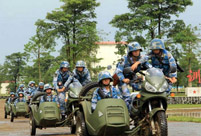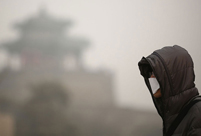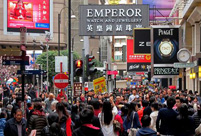 'Jin' named the word of the year by cross-strait netizens
'Jin' named the word of the year by cross-strait netizens Chinese scientific expedition goes to build new Antarctica station
Chinese scientific expedition goes to build new Antarctica station
 Chinese naval escort fleet conducts replenishment in Indian Ocean
Chinese naval escort fleet conducts replenishment in Indian Ocean 17th joint patrol of Mekong River to start
17th joint patrol of Mekong River to start China's moon rover, lander photograph each other
China's moon rover, lander photograph each other Teaming up against polluters
Teaming up against polluters
Core Area of Han River Culture
The Yangtze River, the Yellow River, the Huai River, and the Han River were usually mentioned together in ancient China. The Han River drainage basin is one of the birthplaces of the Chinese nation. Xiangyang, located in the middle reaches of the Han River, connected regions in all directions. "Xiangyang has been a key city for generations since the Han and Jin Dynasties" and the most important city in the Han River drainage basin. Due to its special geographic location, Xiangyang has been the regional economic, political, and cultural center in history and a representative region with important influence on the Han River Culture, which is mainly reflected in: firstly, Xiangyang has a long history of commercial civilization. The Han River is the most convenient, smoothest, and busiest "golden water channel" among inland rivers in ancient China. Xiangyang is known as "the Strategic Passage of North and South" and "A Thoroughfare of Seven Provinces", and is the most important ferry terminal in the Han River drainage basin with a history of commercial civilization more than 2000 years. Secondly, Xiangyang has a flourishing poetry and prose culture. Two sources of Chinese culture, The Book of Songs and The Songs of Chu, originate in the Han River drainage basin. The goddess of the Han River described in The Book of Songs Han Guang is the earliest River Goddess image with the most profound influence in the history of Chinese literature. This permanent image is still popular with modern people. Through ages, the goddess of the Han River becomes the beautiful, kind, intelligent, and noble symbol of the tens of millions of Han River girls, on which the people of the Han River drainage basin place their pursuit for beauty, praise for kindness, and yearn for love in different periods and cultural backgrounds. Song Yu and Wang Yi in Xiangyang were masters of the Songs of Chu. Song Yu further promoted the transition from Songs of Chu Odes, and Wang Yi further wrote Chapters and Sentences for Songs of Chu. Numerous ancient poems were created here to praise the beautiful landscape and tales of Xiangyang. More than 2500 poems have been published clearly and documented well. Particularly, as many as more than 300 Tang poems are the most flourishing. Xiangyang is the highland of the Tang Poetry era recognized by Chinese literature historians. All famous poets in the Tang Dynasty, including Li Bai, Du Fu, Wang Wei, Meng Haoran, Zhang Ji, Pi Rixiu, and Bai Juyi, once wrote poems praising or relating to Xiangyang. Three Hundred Tang Poems collects 27 poems about Xiangyang, including 15 of Meng Xiangyao's poems. Thirdly, Xiangyang's painting and calligraphy culture has a great influence. Xiangyang is "the famous city of Chinese calligraphy". Representatives in history include: Liang Gu and Handan Chun in the Three Kingdoms Period, Ding Daohu and Du Shenyan from the Sui and Tang Dynasties, and Mi Fu, Mi Youren, and Zhang Youzheng from the Northern Song Dynasty. Mi Fu, known as "Mi Xiangyang", was hailed as "four calligraphers of Song Dynasty" together with Su Shi, Huang Tingjian, and Cai Xiang. Mi Fu's paintings were famous for "Mi's Landscape Painting". His Yan Shan Ming has been people's model of calligraphy for practice in thousands of years. Xiangyang's Han River Culture has a profound influence. If Hanzhong Prefecture in the upper reaches of the Han River is said to be the source of the Western Han Dynasty, then Xiangyang Prefecture in the middle reaches of the Han River is the source of the Eastern Han Dynasty. After gaining fame and fortune in Chongling, Liu Xiu revived the Han Dynasty and became the first emperor of the Eastern Han Dynasty, which entitled Xiangyang a great influence on the transmission of the Han River Culture. South Korea still follows the organizational system of Han Dynasty to set Xiangyang Prefecture and retain the place names of Xiangyang including Xianshan, Hanshui, Lumen, and Taipingmen. Streets and parks named after Xiangyang are also found in America, Japan, Taiwan, Hong Kong, Shanghai, and Tianjin.


 Commemorate 120th birth anniversary of Mao Zedong
Commemorate 120th birth anniversary of Mao Zedong Female soldiers of PLA Marine Corps in training
Female soldiers of PLA Marine Corps in training Chinese cities to have a very grey Christmas as smog persists
Chinese cities to have a very grey Christmas as smog persists China and U.S. - the national image in each other’s eyes
China and U.S. - the national image in each other’s eyes The Liaoning's combat capability tested in sea trial
The Liaoning's combat capability tested in sea trial Chinese pole dancing team show their moves in snow
Chinese pole dancing team show their moves in snow Rime scenery in Mount Huangshan
Rime scenery in Mount Huangshan Ronnie O'Sullivan: My children mean the world to me
Ronnie O'Sullivan: My children mean the world to me Shopping in Hong Kong: a different picture
Shopping in Hong Kong: a different picture SWAT conducts anti-terror raid drill
SWAT conducts anti-terror raid drill AK-47 inventor dies at 94
AK-47 inventor dies at 94 Mother practices Taiji with her son
Mother practices Taiji with her son  Crashed French helicopter salvaged
Crashed French helicopter salvaged Winter travels in Anhui
Winter travels in Anhui  Bird show opens to public in Calcutta, India
Bird show opens to public in Calcutta, IndiaDay|Week|Month